Effective Leadership: Theories, Applications, and Case Studies Essay
VerifiedAdded on 2020/11/12
|7
|1573
|251
Essay
AI Summary
This essay delves into the multifaceted realm of leadership, primarily focusing on the significance of participative leadership styles within organizational contexts. It elucidates various leadership theories, providing a detailed analysis of their characteristics and applications, with a particular emphasis on collective, democratic, autocratic, and consensus approaches. The essay then demonstrates the practical implementation of these theories through case studies of prominent multinational corporations, including Marks and Spencer (M&S) and Tesco. By examining the leadership strategies adopted by these companies, the essay illustrates how participative leadership fosters employee engagement, enhances teamwork, and contributes to the achievement of both short-term and long-term organizational objectives. The conclusion reinforces the critical role of effective leadership in cultivating a productive and motivated workforce, thereby driving overall organizational success.
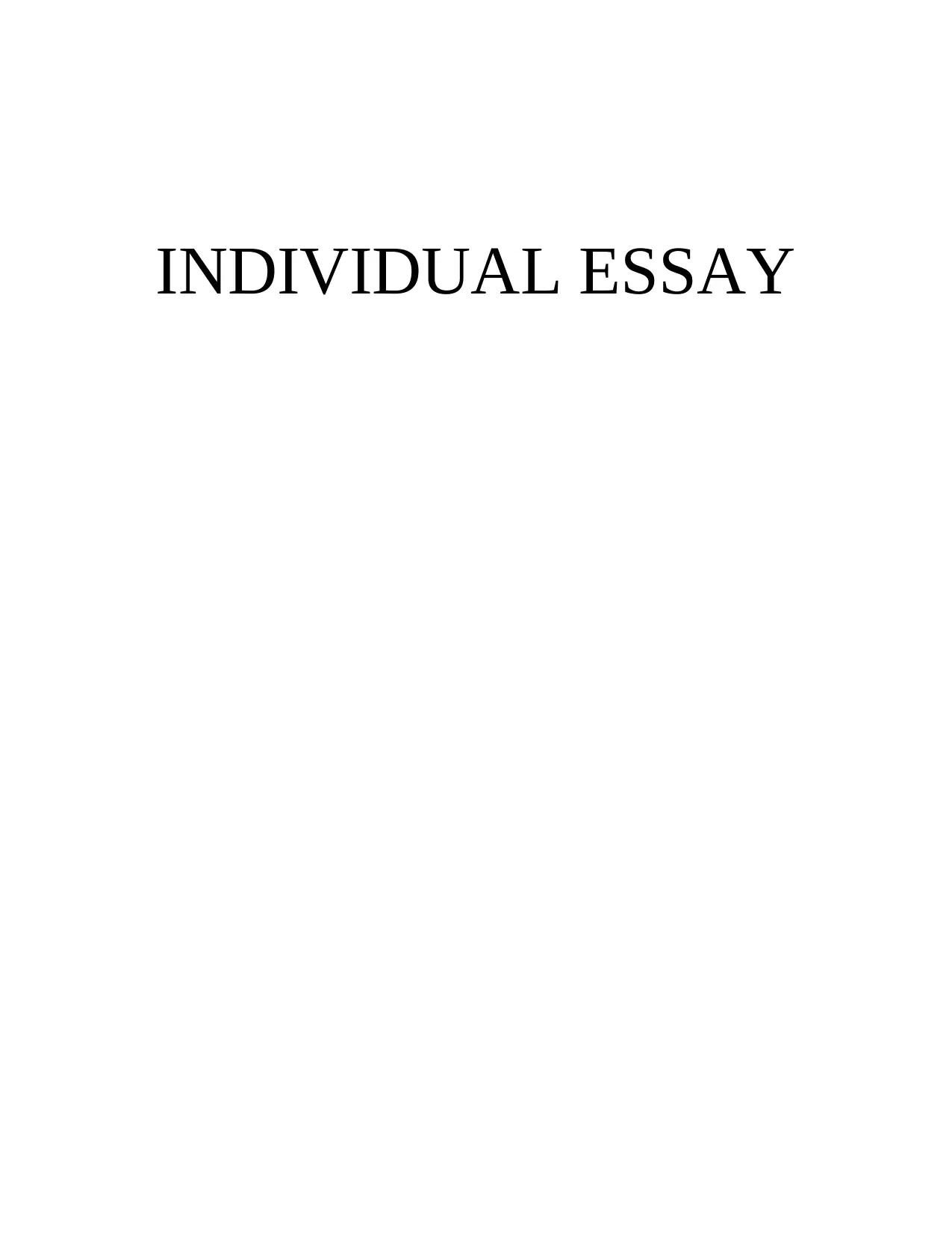
INDIVIDUAL ESSAY
Paraphrase This Document
Need a fresh take? Get an instant paraphrase of this document with our AI Paraphraser
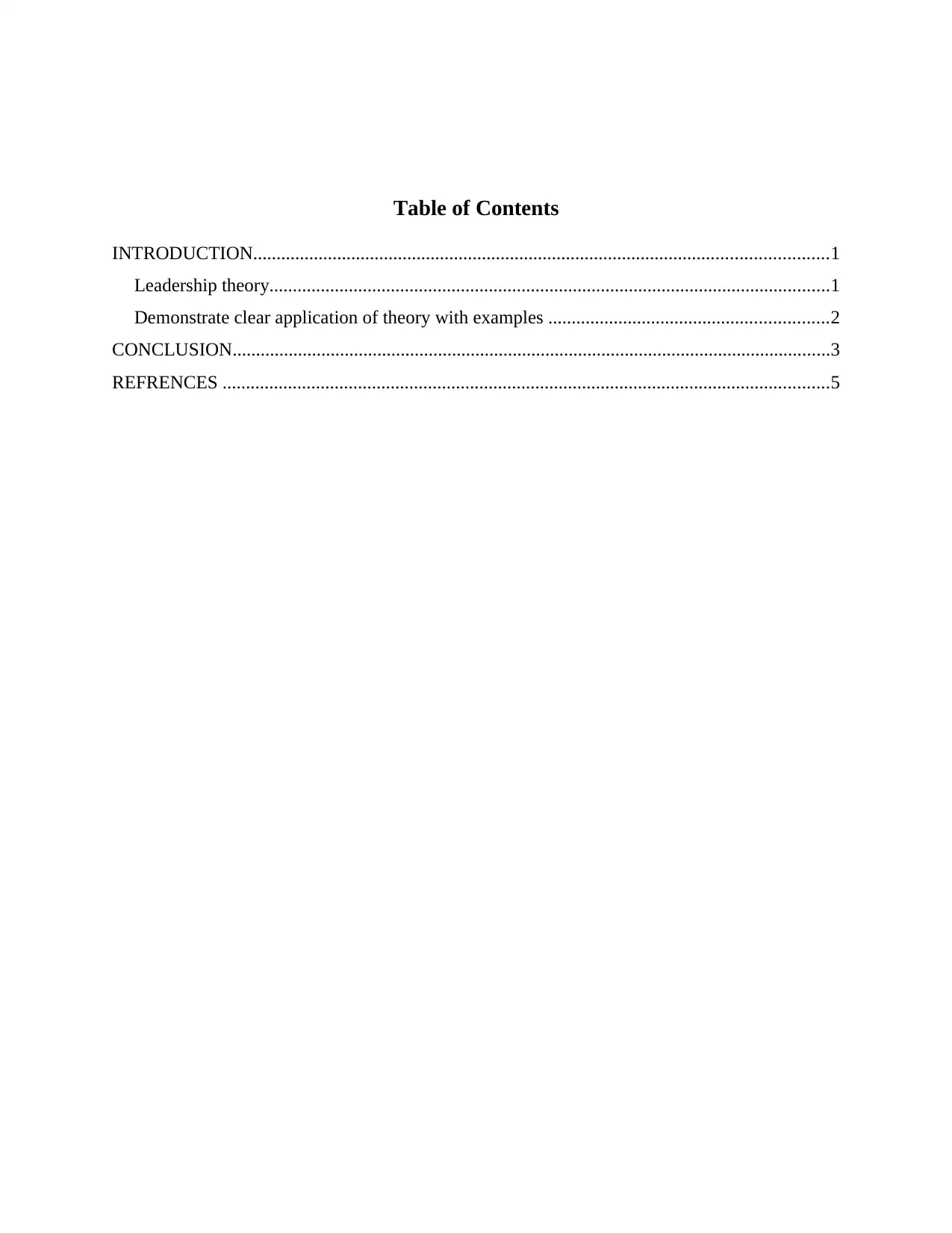
Table of Contents
INTRODUCTION...........................................................................................................................1
Leadership theory........................................................................................................................1
Demonstrate clear application of theory with examples ............................................................2
CONCLUSION................................................................................................................................3
REFRENCES ..................................................................................................................................5
INTRODUCTION...........................................................................................................................1
Leadership theory........................................................................................................................1
Demonstrate clear application of theory with examples ............................................................2
CONCLUSION................................................................................................................................3
REFRENCES ..................................................................................................................................5
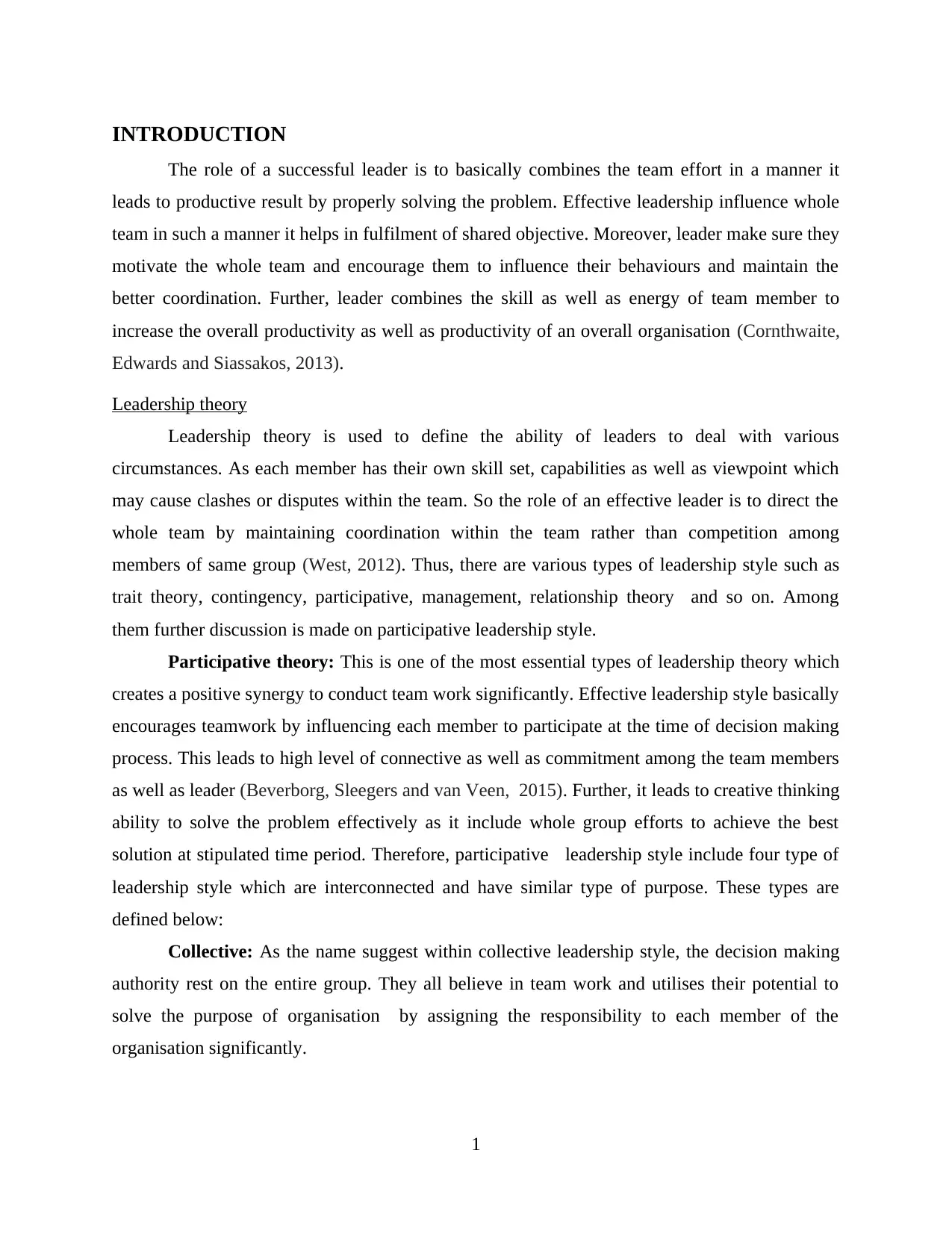
INTRODUCTION
The role of a successful leader is to basically combines the team effort in a manner it
leads to productive result by properly solving the problem. Effective leadership influence whole
team in such a manner it helps in fulfilment of shared objective. Moreover, leader make sure they
motivate the whole team and encourage them to influence their behaviours and maintain the
better coordination. Further, leader combines the skill as well as energy of team member to
increase the overall productivity as well as productivity of an overall organisation (Cornthwaite,
Edwards and Siassakos, 2013).
Leadership theory
Leadership theory is used to define the ability of leaders to deal with various
circumstances. As each member has their own skill set, capabilities as well as viewpoint which
may cause clashes or disputes within the team. So the role of an effective leader is to direct the
whole team by maintaining coordination within the team rather than competition among
members of same group (West, 2012). Thus, there are various types of leadership style such as
trait theory, contingency, participative, management, relationship theory and so on. Among
them further discussion is made on participative leadership style.
Participative theory: This is one of the most essential types of leadership theory which
creates a positive synergy to conduct team work significantly. Effective leadership style basically
encourages teamwork by influencing each member to participate at the time of decision making
process. This leads to high level of connective as well as commitment among the team members
as well as leader (Beverborg, Sleegers and van Veen, 2015). Further, it leads to creative thinking
ability to solve the problem effectively as it include whole group efforts to achieve the best
solution at stipulated time period. Therefore, participative leadership style include four type of
leadership style which are interconnected and have similar type of purpose. These types are
defined below:
Collective: As the name suggest within collective leadership style, the decision making
authority rest on the entire group. They all believe in team work and utilises their potential to
solve the purpose of organisation by assigning the responsibility to each member of the
organisation significantly.
1
The role of a successful leader is to basically combines the team effort in a manner it
leads to productive result by properly solving the problem. Effective leadership influence whole
team in such a manner it helps in fulfilment of shared objective. Moreover, leader make sure they
motivate the whole team and encourage them to influence their behaviours and maintain the
better coordination. Further, leader combines the skill as well as energy of team member to
increase the overall productivity as well as productivity of an overall organisation (Cornthwaite,
Edwards and Siassakos, 2013).
Leadership theory
Leadership theory is used to define the ability of leaders to deal with various
circumstances. As each member has their own skill set, capabilities as well as viewpoint which
may cause clashes or disputes within the team. So the role of an effective leader is to direct the
whole team by maintaining coordination within the team rather than competition among
members of same group (West, 2012). Thus, there are various types of leadership style such as
trait theory, contingency, participative, management, relationship theory and so on. Among
them further discussion is made on participative leadership style.
Participative theory: This is one of the most essential types of leadership theory which
creates a positive synergy to conduct team work significantly. Effective leadership style basically
encourages teamwork by influencing each member to participate at the time of decision making
process. This leads to high level of connective as well as commitment among the team members
as well as leader (Beverborg, Sleegers and van Veen, 2015). Further, it leads to creative thinking
ability to solve the problem effectively as it include whole group efforts to achieve the best
solution at stipulated time period. Therefore, participative leadership style include four type of
leadership style which are interconnected and have similar type of purpose. These types are
defined below:
Collective: As the name suggest within collective leadership style, the decision making
authority rest on the entire group. They all believe in team work and utilises their potential to
solve the purpose of organisation by assigning the responsibility to each member of the
organisation significantly.
1
⊘ This is a preview!⊘
Do you want full access?
Subscribe today to unlock all pages.

Trusted by 1+ million students worldwide
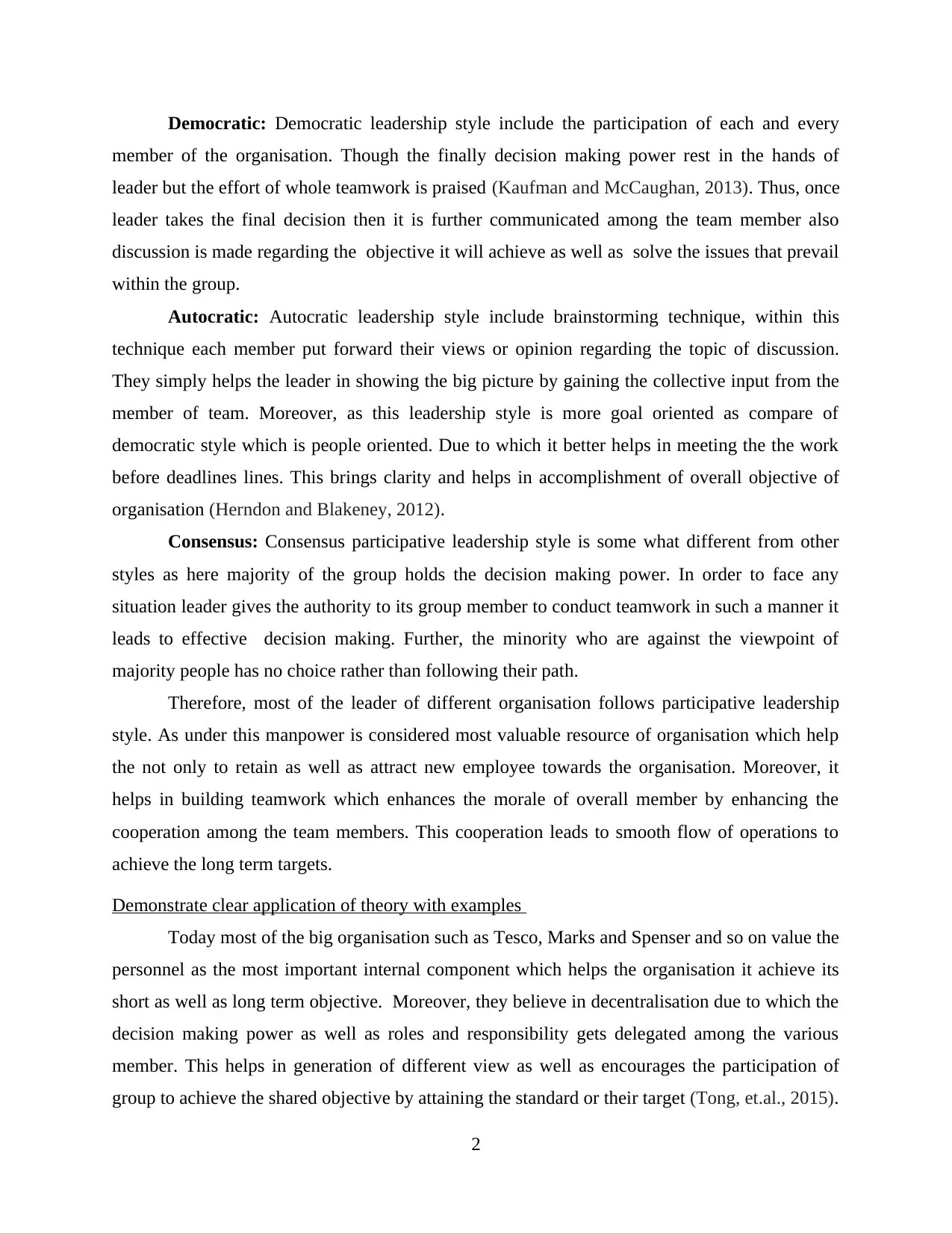
Democratic: Democratic leadership style include the participation of each and every
member of the organisation. Though the finally decision making power rest in the hands of
leader but the effort of whole teamwork is praised (Kaufman and McCaughan, 2013). Thus, once
leader takes the final decision then it is further communicated among the team member also
discussion is made regarding the objective it will achieve as well as solve the issues that prevail
within the group.
Autocratic: Autocratic leadership style include brainstorming technique, within this
technique each member put forward their views or opinion regarding the topic of discussion.
They simply helps the leader in showing the big picture by gaining the collective input from the
member of team. Moreover, as this leadership style is more goal oriented as compare of
democratic style which is people oriented. Due to which it better helps in meeting the the work
before deadlines lines. This brings clarity and helps in accomplishment of overall objective of
organisation (Herndon and Blakeney, 2012).
Consensus: Consensus participative leadership style is some what different from other
styles as here majority of the group holds the decision making power. In order to face any
situation leader gives the authority to its group member to conduct teamwork in such a manner it
leads to effective decision making. Further, the minority who are against the viewpoint of
majority people has no choice rather than following their path.
Therefore, most of the leader of different organisation follows participative leadership
style. As under this manpower is considered most valuable resource of organisation which help
the not only to retain as well as attract new employee towards the organisation. Moreover, it
helps in building teamwork which enhances the morale of overall member by enhancing the
cooperation among the team members. This cooperation leads to smooth flow of operations to
achieve the long term targets.
Demonstrate clear application of theory with examples
Today most of the big organisation such as Tesco, Marks and Spenser and so on value the
personnel as the most important internal component which helps the organisation it achieve its
short as well as long term objective. Moreover, they believe in decentralisation due to which the
decision making power as well as roles and responsibility gets delegated among the various
member. This helps in generation of different view as well as encourages the participation of
group to achieve the shared objective by attaining the standard or their target (Tong, et.al., 2015).
2
member of the organisation. Though the finally decision making power rest in the hands of
leader but the effort of whole teamwork is praised (Kaufman and McCaughan, 2013). Thus, once
leader takes the final decision then it is further communicated among the team member also
discussion is made regarding the objective it will achieve as well as solve the issues that prevail
within the group.
Autocratic: Autocratic leadership style include brainstorming technique, within this
technique each member put forward their views or opinion regarding the topic of discussion.
They simply helps the leader in showing the big picture by gaining the collective input from the
member of team. Moreover, as this leadership style is more goal oriented as compare of
democratic style which is people oriented. Due to which it better helps in meeting the the work
before deadlines lines. This brings clarity and helps in accomplishment of overall objective of
organisation (Herndon and Blakeney, 2012).
Consensus: Consensus participative leadership style is some what different from other
styles as here majority of the group holds the decision making power. In order to face any
situation leader gives the authority to its group member to conduct teamwork in such a manner it
leads to effective decision making. Further, the minority who are against the viewpoint of
majority people has no choice rather than following their path.
Therefore, most of the leader of different organisation follows participative leadership
style. As under this manpower is considered most valuable resource of organisation which help
the not only to retain as well as attract new employee towards the organisation. Moreover, it
helps in building teamwork which enhances the morale of overall member by enhancing the
cooperation among the team members. This cooperation leads to smooth flow of operations to
achieve the long term targets.
Demonstrate clear application of theory with examples
Today most of the big organisation such as Tesco, Marks and Spenser and so on value the
personnel as the most important internal component which helps the organisation it achieve its
short as well as long term objective. Moreover, they believe in decentralisation due to which the
decision making power as well as roles and responsibility gets delegated among the various
member. This helps in generation of different view as well as encourages the participation of
group to achieve the shared objective by attaining the standard or their target (Tong, et.al., 2015).
2
Paraphrase This Document
Need a fresh take? Get an instant paraphrase of this document with our AI Paraphraser
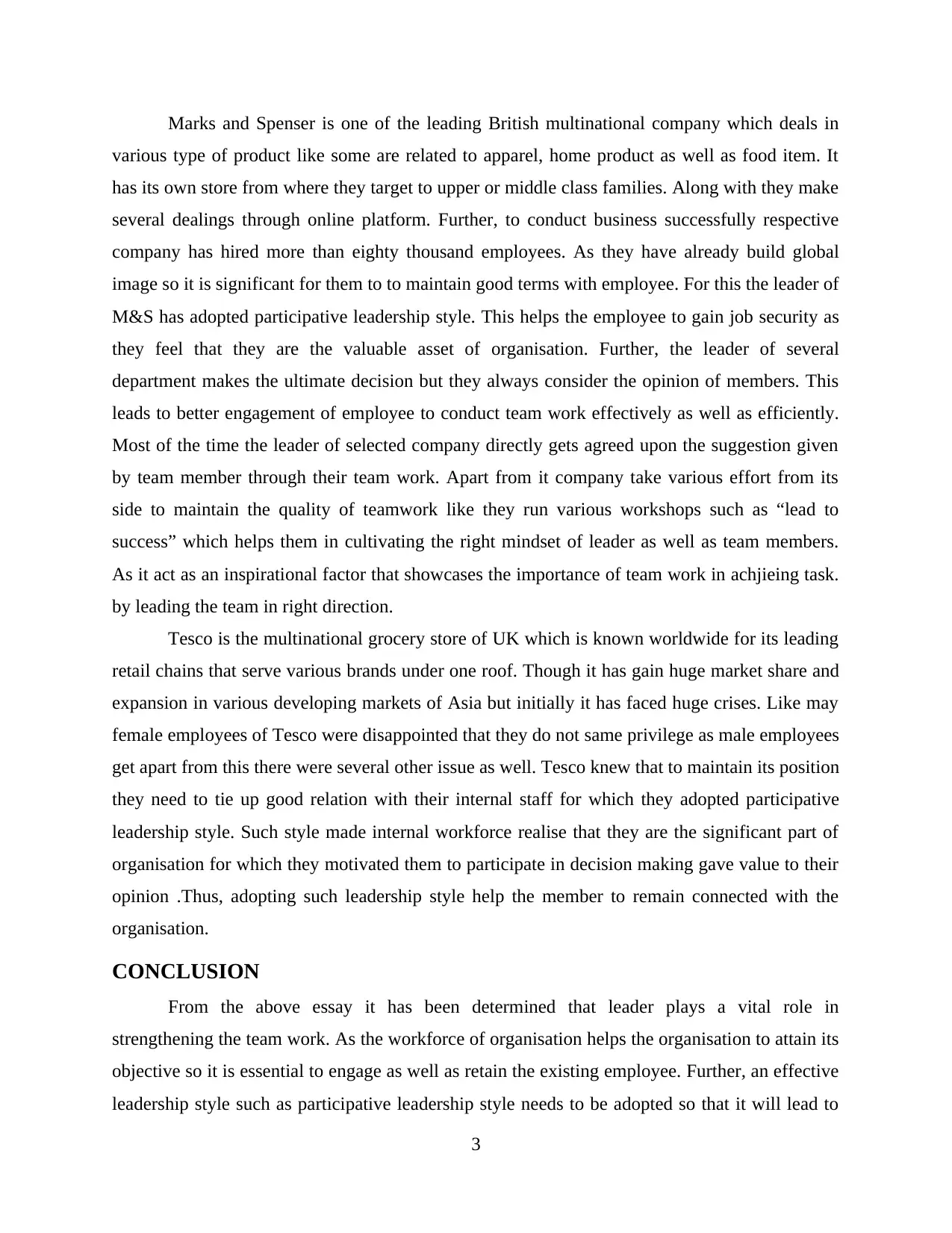
Marks and Spenser is one of the leading British multinational company which deals in
various type of product like some are related to apparel, home product as well as food item. It
has its own store from where they target to upper or middle class families. Along with they make
several dealings through online platform. Further, to conduct business successfully respective
company has hired more than eighty thousand employees. As they have already build global
image so it is significant for them to to maintain good terms with employee. For this the leader of
M&S has adopted participative leadership style. This helps the employee to gain job security as
they feel that they are the valuable asset of organisation. Further, the leader of several
department makes the ultimate decision but they always consider the opinion of members. This
leads to better engagement of employee to conduct team work effectively as well as efficiently.
Most of the time the leader of selected company directly gets agreed upon the suggestion given
by team member through their team work. Apart from it company take various effort from its
side to maintain the quality of teamwork like they run various workshops such as “lead to
success” which helps them in cultivating the right mindset of leader as well as team members.
As it act as an inspirational factor that showcases the importance of team work in achjieing task.
by leading the team in right direction.
Tesco is the multinational grocery store of UK which is known worldwide for its leading
retail chains that serve various brands under one roof. Though it has gain huge market share and
expansion in various developing markets of Asia but initially it has faced huge crises. Like may
female employees of Tesco were disappointed that they do not same privilege as male employees
get apart from this there were several other issue as well. Tesco knew that to maintain its position
they need to tie up good relation with their internal staff for which they adopted participative
leadership style. Such style made internal workforce realise that they are the significant part of
organisation for which they motivated them to participate in decision making gave value to their
opinion .Thus, adopting such leadership style help the member to remain connected with the
organisation.
CONCLUSION
From the above essay it has been determined that leader plays a vital role in
strengthening the team work. As the workforce of organisation helps the organisation to attain its
objective so it is essential to engage as well as retain the existing employee. Further, an effective
leadership style such as participative leadership style needs to be adopted so that it will lead to
3
various type of product like some are related to apparel, home product as well as food item. It
has its own store from where they target to upper or middle class families. Along with they make
several dealings through online platform. Further, to conduct business successfully respective
company has hired more than eighty thousand employees. As they have already build global
image so it is significant for them to to maintain good terms with employee. For this the leader of
M&S has adopted participative leadership style. This helps the employee to gain job security as
they feel that they are the valuable asset of organisation. Further, the leader of several
department makes the ultimate decision but they always consider the opinion of members. This
leads to better engagement of employee to conduct team work effectively as well as efficiently.
Most of the time the leader of selected company directly gets agreed upon the suggestion given
by team member through their team work. Apart from it company take various effort from its
side to maintain the quality of teamwork like they run various workshops such as “lead to
success” which helps them in cultivating the right mindset of leader as well as team members.
As it act as an inspirational factor that showcases the importance of team work in achjieing task.
by leading the team in right direction.
Tesco is the multinational grocery store of UK which is known worldwide for its leading
retail chains that serve various brands under one roof. Though it has gain huge market share and
expansion in various developing markets of Asia but initially it has faced huge crises. Like may
female employees of Tesco were disappointed that they do not same privilege as male employees
get apart from this there were several other issue as well. Tesco knew that to maintain its position
they need to tie up good relation with their internal staff for which they adopted participative
leadership style. Such style made internal workforce realise that they are the significant part of
organisation for which they motivated them to participate in decision making gave value to their
opinion .Thus, adopting such leadership style help the member to remain connected with the
organisation.
CONCLUSION
From the above essay it has been determined that leader plays a vital role in
strengthening the team work. As the workforce of organisation helps the organisation to attain its
objective so it is essential to engage as well as retain the existing employee. Further, an effective
leadership style such as participative leadership style needs to be adopted so that it will lead to
3

transparency and employee will not feel like their opinion are not considered valuable. Thus,
effective leadership style leads to effective teamwork that helps in fulfilment of overall objective.
4
effective leadership style leads to effective teamwork that helps in fulfilment of overall objective.
4
⊘ This is a preview!⊘
Do you want full access?
Subscribe today to unlock all pages.

Trusted by 1+ million students worldwide
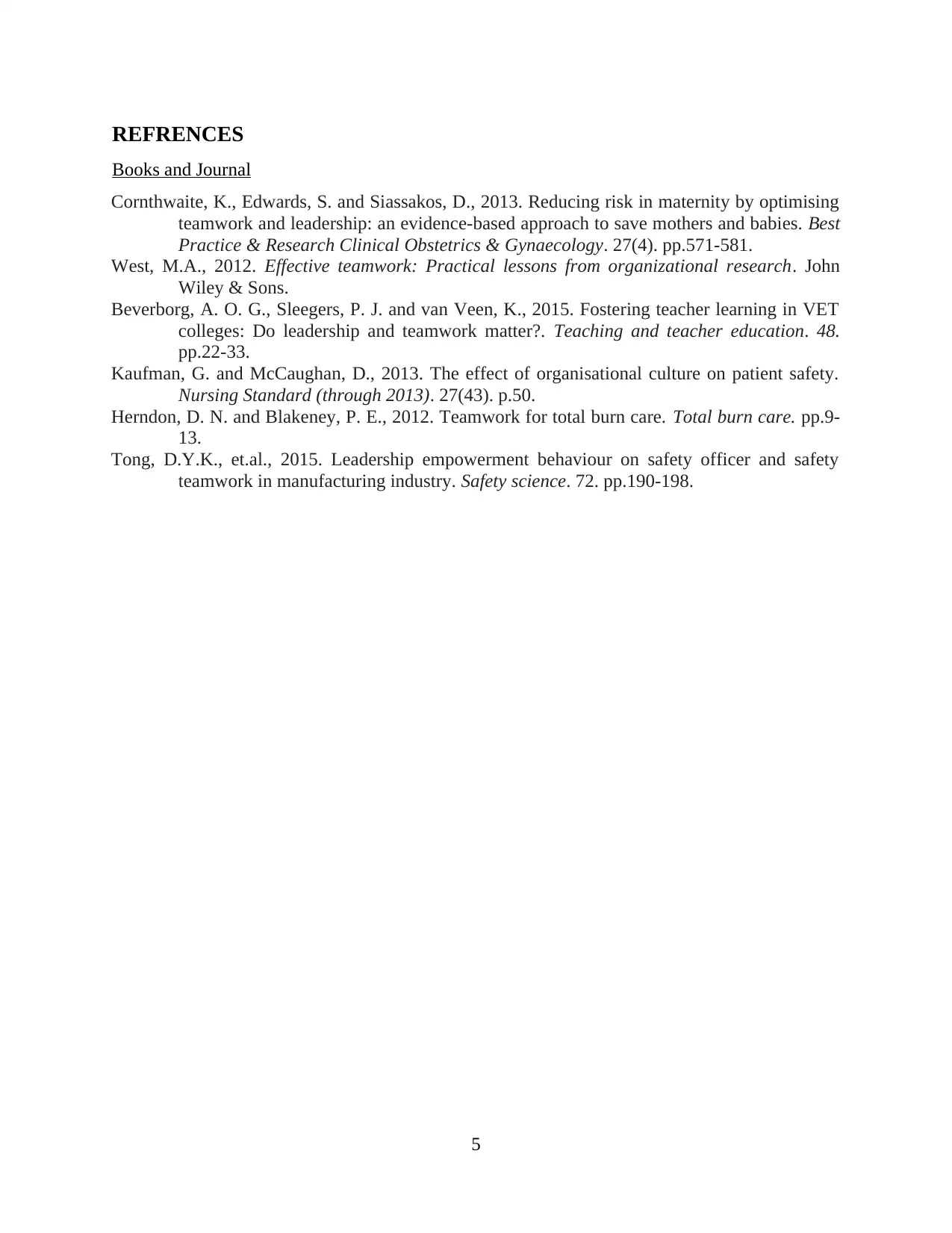
REFRENCES
Books and Journal
Cornthwaite, K., Edwards, S. and Siassakos, D., 2013. Reducing risk in maternity by optimising
teamwork and leadership: an evidence-based approach to save mothers and babies. Best
Practice & Research Clinical Obstetrics & Gynaecology. 27(4). pp.571-581.
West, M.A., 2012. Effective teamwork: Practical lessons from organizational research. John
Wiley & Sons.
Beverborg, A. O. G., Sleegers, P. J. and van Veen, K., 2015. Fostering teacher learning in VET
colleges: Do leadership and teamwork matter?. Teaching and teacher education. 48.
pp.22-33.
Kaufman, G. and McCaughan, D., 2013. The effect of organisational culture on patient safety.
Nursing Standard (through 2013). 27(43). p.50.
Herndon, D. N. and Blakeney, P. E., 2012. Teamwork for total burn care. Total burn care. pp.9-
13.
Tong, D.Y.K., et.al., 2015. Leadership empowerment behaviour on safety officer and safety
teamwork in manufacturing industry. Safety science. 72. pp.190-198.
5
Books and Journal
Cornthwaite, K., Edwards, S. and Siassakos, D., 2013. Reducing risk in maternity by optimising
teamwork and leadership: an evidence-based approach to save mothers and babies. Best
Practice & Research Clinical Obstetrics & Gynaecology. 27(4). pp.571-581.
West, M.A., 2012. Effective teamwork: Practical lessons from organizational research. John
Wiley & Sons.
Beverborg, A. O. G., Sleegers, P. J. and van Veen, K., 2015. Fostering teacher learning in VET
colleges: Do leadership and teamwork matter?. Teaching and teacher education. 48.
pp.22-33.
Kaufman, G. and McCaughan, D., 2013. The effect of organisational culture on patient safety.
Nursing Standard (through 2013). 27(43). p.50.
Herndon, D. N. and Blakeney, P. E., 2012. Teamwork for total burn care. Total burn care. pp.9-
13.
Tong, D.Y.K., et.al., 2015. Leadership empowerment behaviour on safety officer and safety
teamwork in manufacturing industry. Safety science. 72. pp.190-198.
5
1 out of 7
Related Documents
Your All-in-One AI-Powered Toolkit for Academic Success.
+13062052269
info@desklib.com
Available 24*7 on WhatsApp / Email
![[object Object]](/_next/static/media/star-bottom.7253800d.svg)
Unlock your academic potential
Copyright © 2020–2025 A2Z Services. All Rights Reserved. Developed and managed by ZUCOL.





